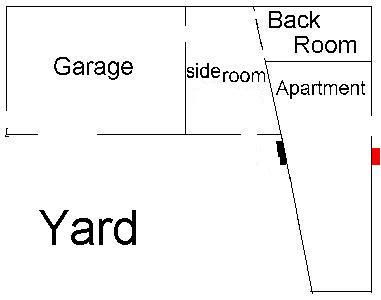jaylectricity
Senior Member
- Location
- Massachusetts
- Occupation
- licensed journeyman electrician
Mostly a commercial property, this has a 240V single phase service that supplied entire area. We are going to do away with the existing service (red block in pic) and put a new one in place (black box).
I was hoping to avoid a main disconnect before the meters, but it looks like we're gonna need at least a 400 amp service. The apartment has 100 at the moment, but it really only needs 60. There is no access from the apartment into the yard, a fence divides it, so no common area.
Customer wants to have a 300 amp service going to the rest of the building, plus an additional space for a 3rd meter in case a common meter becomes necessary, or they want the side and back room to have their own meter.
The garage is where most of the power will be needed, although we don't know for sure exactly the load necessary other than a few welding machines, compressors, and other tools.
I haven't installed a service this big, ever, but it's imperative that I do this. This is a long time customer, but he usually deals with multi-family homes as opposed to having commercial space. I'm not worried about him finding somebody who would do what I do for less money, I'm worried about him finding somebody who knows that less needs to be done to satisfy his requirements. Therefore I don't want to install a main disconnect if not needed.
Questions:
1. I feel like a 400 amp service is required to have a main disconnect ahead of the meters, where might I have gotten that idea? (code article, please)
2. Is 300 amps a standard at all? Will it raise the cost of the install significantly as opposed to a 250A, 350A or even 400A meter socket? I'm wondering if it would be better to bring two 200A feeders through separate meters into the commercial space and tell him to pay two separate electric bills.
3. Anybody familiar with enough meter banks to suggest one that I use?
4. At what point should we spend extra money on bolt-on-breaker panels?

I was hoping to avoid a main disconnect before the meters, but it looks like we're gonna need at least a 400 amp service. The apartment has 100 at the moment, but it really only needs 60. There is no access from the apartment into the yard, a fence divides it, so no common area.
Customer wants to have a 300 amp service going to the rest of the building, plus an additional space for a 3rd meter in case a common meter becomes necessary, or they want the side and back room to have their own meter.
The garage is where most of the power will be needed, although we don't know for sure exactly the load necessary other than a few welding machines, compressors, and other tools.
I haven't installed a service this big, ever, but it's imperative that I do this. This is a long time customer, but he usually deals with multi-family homes as opposed to having commercial space. I'm not worried about him finding somebody who would do what I do for less money, I'm worried about him finding somebody who knows that less needs to be done to satisfy his requirements. Therefore I don't want to install a main disconnect if not needed.
Questions:
1. I feel like a 400 amp service is required to have a main disconnect ahead of the meters, where might I have gotten that idea? (code article, please)
2. Is 300 amps a standard at all? Will it raise the cost of the install significantly as opposed to a 250A, 350A or even 400A meter socket? I'm wondering if it would be better to bring two 200A feeders through separate meters into the commercial space and tell him to pay two separate electric bills.
3. Anybody familiar with enough meter banks to suggest one that I use?
4. At what point should we spend extra money on bolt-on-breaker panels?


